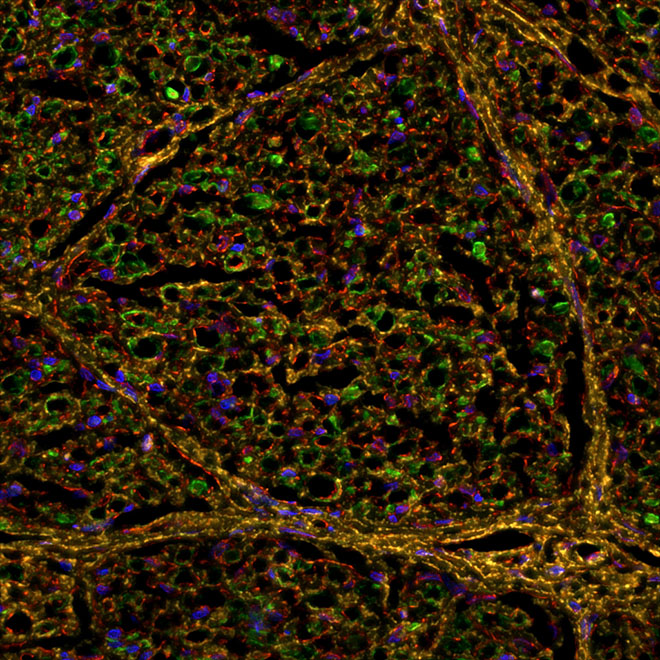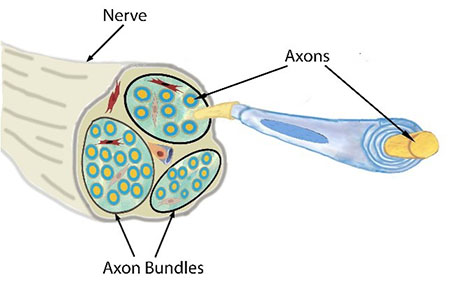Taste Nerve Reveals Coronavirus Entryways
Research Quick Pics
Sprinkled like confetti throughout this image are dozens of green-, yellow-, and red-ringed axons—nerve cell fibers that transmit electrical signals throughout the nervous system. The axons are bundled in a human cranial nerve, shown here in a cross-section view (see illustration below for context). Nerves like this exit the brainstem and project to areas of the tongue, mouth, and throat, where taste signals are detected and relayed back to the brain.
A research team led by NIDCR senior investigator Eva Mezey, MD, PhD, found that the outer surfaces of the axons in these nerves are studded with protein “entry factors” used by the SARS-CoV-2 virus to invade cells. The presence of entry factors like TMPRSS2 proteins (yellow) and ACE2 receptors (red) points to the possibility that the virus could infect taste-sensing nerves and offers a potential explanation for the taste loss that affects about 39% of those who have COVID-19.
Mezey says the results suggest that viruses like SARS-CoV-2 could reach the central nervous system by traveling in nerves from the mouth. “The nerve terminals around the taste buds and gums could be a back door for pathogens to get into the brain,” she says. Mezey and her team are exploring this possibility in mice by determining whether and how certain oral bacteria can travel from the mouth to the brain.
Related Links
- Scientists Identify Mechanism That May Influence Infectivity of SARS-CoV-2 Variants
- Developing a Smart Mask to Surveil Coronavirus
- A Coronavirus Sensor that Fits in the Palm of Your Hand
- Brain Patrol
- Scientists Find Evidence that Novel Coronavirus Infects the Mouth’s Cells
References
SARS-CoV-2 entry sites are present in all structural elements of the human glossopharyngeal and vagal nerves: Clinical implications. Vitale-Cross L, Szalayova I, Scoggins A, Palkovits M, Mezey E. eBioMedicine. 2022 Apr 4; 78: 103981. PMID: 35390636.
Taste loss as a distinct symptom of COVID-19: a systematic review and meta-analysis. Hannum ME, Koch RJ, Ramirez VA, et al. Chem Senses. 2022 Jan 1;47:bjac001. doi:10.1093/chemse/bjac001. PMID: 35171979.
Attention Editors
Reprint this article in your own publication or post to your website. NIDCR News articles are not copyrighted. Please acknowledge NIH's National Institute of Dental and Craniofacial Research as the source.
Subscribe for NIDCR Updates
Receive email updates about the latest advances in dental, oral, and craniofacial research.
June 2024


